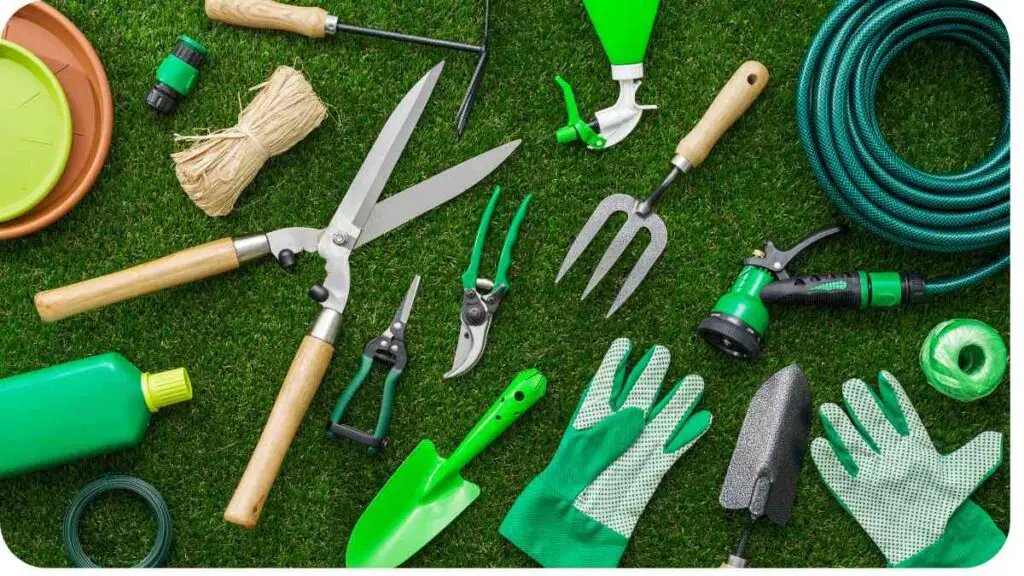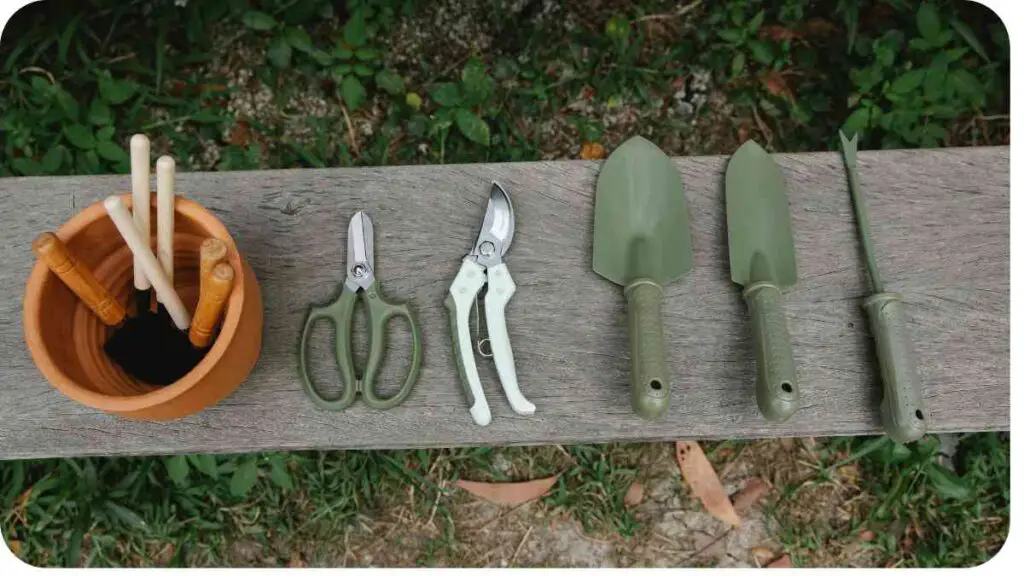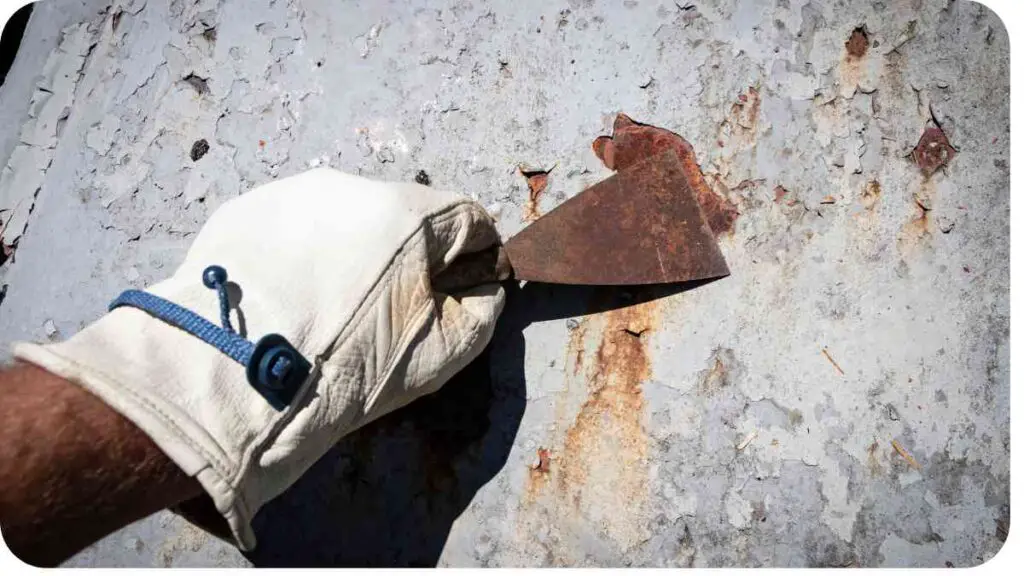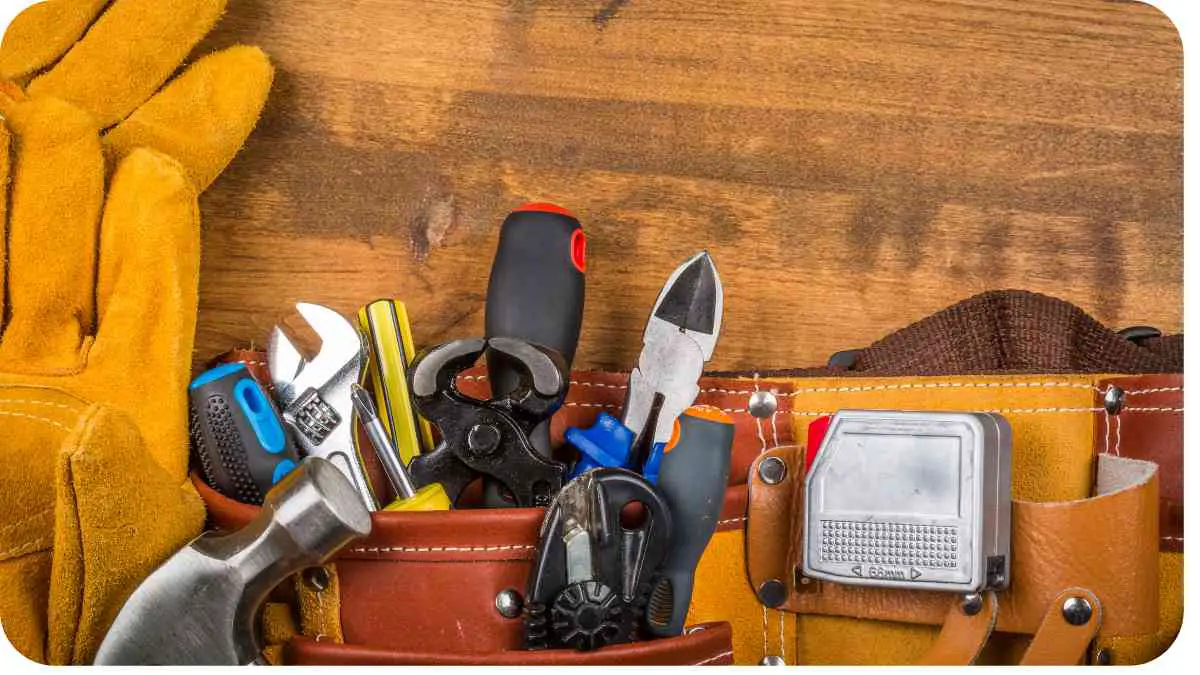Garden tools are essential for maintaining a beautiful and thriving garden. However, over time, these tools are prone to rust, which not only affects their appearance but also their functionality. In this comprehensive guide, we’ll delve into the process of repairing rusted garden tools through effective cleaning and maintenance techniques.
| Takeaways |
|---|
| Regular maintenance is essential to prevent rust on garden tools. |
| Proper cleaning and drying after use help prolong tool lifespan. |
| Store tools in a dry environment to prevent moisture buildup. |
| Apply protective coatings to metal surfaces to prevent oxidation. |
| Inspect tools regularly for signs of rust and address promptly. |
| Utilize DIY or professional rust removal methods as needed. |
| Prioritize the care and maintenance of garden tools for optimal performance. |
2. Understanding Rust and Its Impact

Rust is the result of a chemical reaction known as oxidation, which occurs when iron or steel comes into contact with moisture and oxygen over time. This process leads to the formation of iron oxide, commonly known as rust. When garden tools are left exposed to the elements or stored improperly, they are susceptible to rust formation.
Restoring cracked or chipped outdoor planters can significantly enhance your garden’s aesthetics. If you’re facing this issue, learning how to repair cracked or chipped outdoor planters can save you money and prolong the life of your garden decor.
Table 1: Common Causes of Rust Formation
| Cause | Description |
|---|---|
| Exposure to Moisture | Rain, dew, or watering can lead to moisture accumulation on garden tools, accelerating rust. |
| Lack of Proper Storage | Storing tools in damp or humid environments promotes rust formation. |
| Contact with Soil and Organic Matter | Soil contains moisture and organic compounds that can contribute to rusting. |
| Neglecting Regular Maintenance | Failure to clean and oil garden tools regularly allows rust to develop unchecked. |
3. Tools and Materials Needed for Cleaning Rusty Garden Tools
Before you embark on the journey of restoring your rusty garden tools, gather the necessary supplies to ensure a smooth and efficient process.
Table 2: Essential Tools and Materials
| Tool/Material | Description |
|---|---|
| Wire Brush | Removes loose rust and debris from the surface of garden tools. |
| Sandpaper or Emery Cloth | Used for sanding and smoothing the metal surface to remove stubborn rust spots. |
| Steel Wool | Effective for polishing and buffing away rust from metal surfaces. |
| White Vinegar | Acts as a natural rust remover due to its acidic properties. |
| Rust Converter | Chemical solution that converts rust into a stable compound, preventing further corrosion. |
| Protective Gloves | Prevents skin irritation and protects hands from exposure to chemicals. |
| Rag or Cloth | Used for applying rust remover and wiping down garden tools. |
| Lubricating Oil | Lubricates metal surfaces to prevent future rust formation. |
| Container or Bucket | For soaking rusty tools in rust remover solution. |
| Safety Goggles | Protects eyes from potential splashes of rust remover and debris. |
4. Step-by-Step Guide to Cleaning Rusty Garden Tools
Now that you have assembled your tools and materials, let’s dive into the process of cleaning rusty garden tools effectively.
Over time, outdoor furniture can become weathered and worn. To bring it back to life, consider these tips for restoring weathered wooden outdoor furniture, ensuring your garden remains an inviting space for relaxation.
Table 3: Step-by-Step Cleaning Process
| Step | Description |
|---|---|
| 1. Assessment | Inspect each garden tool for the extent of rust damage and identify areas needing attention. |
| 2. Remove Debris | Use a wire brush to remove any dirt, debris, and loose rust from the surface of the tools. |
| 3. Sanding | Use sandpaper or emery cloth to sand away stubborn rust spots until the metal surface is smooth. |
| 4. Rust Removal | Apply white vinegar or rust converter to the affected areas and let it sit for the recommended time. |
| 5. Scrubbing | Use steel wool to scrub away remaining rust, focusing on intricate or hard-to-reach areas. |
| 6. Rinse and Dry | Rinse the tools with water to remove any residue and dry them thoroughly to prevent future rusting. |
| 7. Lubrication | Apply a thin layer of lubricating oil to the clean, dry surfaces of the garden tools to prevent rust. |
By following these steps diligently, you can restore your rusty garden tools to their former glory and ensure their longevity and effectiveness in your garden tasks.
5. Preventive Maintenance Tips to Avoid Rust Formation

Prevention is key to minimizing rust formation on your garden tools and prolonging their lifespan. Here are some proactive measures you can take to prevent rust:
Table 4: Preventive Maintenance Tips
| Tip | Description |
|---|---|
| Clean and Dry Tools After Use | Immediately clean dirt and debris from garden tools after each use and dry them thoroughly to prevent moisture buildup. |
| Store Tools Properly | Store tools in a dry environment, such as a shed or garage, away from moisture and humidity. Hang them or store them upright to prevent contact with damp surfaces. |
| Apply a Protective Coating | Coat clean, dry tools with a rust-resistant primer or paint to create a barrier against moisture and oxidation. |
| Use Rust Inhibitors | Apply a rust inhibitor or corrosion-resistant spray to metal surfaces for added protection against rust formation. |
| Regular Inspection and Maintenance | Inspect garden tools regularly for signs of rust or damage, and address any issues promptly to prevent rust from spreading. |
Incorporating these preventive maintenance practices into your gardening routine will help keep your tools rust-free and in optimal condition for years to come.
Effective drainage is crucial for healthy plants in container gardens. If you’re experiencing water retention issues, here’s a guide on dealing with drainage problems in container gardens to help you maintain optimal soil conditions.
6. Common Mistakes to Avoid When Cleaning Rusty Garden Tools
While cleaning rusty garden tools, it’s important to avoid certain mistakes that can worsen the rust or damage the tools. Here are some common pitfalls to steer clear of:
Table 5: Common Mistakes to Avoid
| Mistake | Description |
|---|---|
| Using Abrasive Cleaners | Harsh abrasives can scratch and damage metal surfaces, making them more susceptible to rust. |
| Neglecting Protective Gear | Failure to wear gloves and goggles can result in skin irritation or injury from chemicals and debris. |
| Skipping Rust Removal Steps | Incomplete rust removal can leave behind hidden rust pockets, leading to future corrosion. |
| Storing Tools While Still Damp | Storing damp tools promotes rust formation, so always ensure tools are completely dry before storage. |
| Overlooking Hard-to-Reach Areas | Neglecting to thoroughly clean intricate or hard-to-reach areas can leave rust behind, compromising tool integrity. |
By being mindful of these common mistakes, you can avoid inadvertently causing further damage to your garden tools during the rust removal process.
7. Benefits of Regularly Maintaining Garden Tools
Regular maintenance of garden tools goes beyond just preventing rust; it offers a myriad of benefits that enhance your gardening experience. Here are some advantages of keeping your garden tools in top condition:
Table 6: Benefits of Regular Maintenance
| Benefit | Description |
|---|---|
| Prolonged Lifespan | Proper maintenance extends the lifespan of garden tools, saving you money on frequent replacements. |
| Improved Performance | Well-maintained tools perform better, making gardening tasks easier and more efficient. |
| Reduced Risk of Injury | Maintaining sharp, rust-free tools reduces the risk of accidents and injuries during use. |
| Enhanced Plant Health | Clean tools prevent the spread of diseases and pathogens, promoting healthier plant growth. |
| Time and Energy Savings | Efficient tools require less effort to use, saving you time and energy during gardening activities. |
By investing time and effort into regular maintenance, you can reap these benefits and enjoy a more productive and enjoyable gardening experience.
A well-maintained hose reel is essential for a functional garden setup. If yours is showing signs of wear, explore these repairing worn out garden hose reels solutions to keep your watering system in top shape.
8. Environmental Impact of Rust and Proper Disposal Methods
Rust not only affects the functionality of garden tools but also has environmental implications if not managed properly. When disposing of rusty tools or rust removal materials, it’s essential to consider the environmental impact and follow appropriate disposal methods:
Table 7: Environmental Impact and Disposal Methods
| Impact | Description |
|---|---|
| Soil Contamination | Rust particles can leach into the soil, affecting soil quality and potentially harming plants. |
| Water Pollution | Chemical rust removers can contaminate water sources if not disposed of responsibly. |
| Metal Recycling | Recycling rusty garden tools ensures that the metal is repurposed rather than ending up in landfills. |
| Hazardous Waste Disposal | Dispose of chemical rust removers and contaminated materials at designated hazardous waste facilities. |
By adopting eco-friendly disposal practices and choosing environmentally safe rust removal methods, you can minimize the environmental impact of rust on your garden and surrounding ecosystem.
9. Expert Tips for Effective Rust Removal

For gardeners dealing with stubborn rust on their tools, expert advice can be invaluable. Here are some tips from seasoned professionals for effective rust removal:
Table 8: Expert Rust Removal Tips
| Tip | Description |
|---|---|
| Use Electrolysis | Electrolysis is a chemical process that uses electricity to remove rust effectively from metal surfaces without damaging the underlying metal. |
| DIY Rust Removal Solutions | Homemade rust removal solutions, such as a mixture of baking soda and water or lemon juice and salt, can be effective for mild rust removal. |
| Invest in Rust Removers | Commercial rust removers are formulated to dissolve rust quickly and efficiently, making them ideal for heavily rusted tools. |
| Practice Regular Maintenance | Consistent cleaning and oiling of garden tools after each use prevent rust buildup and make future rust removal easier. |
By incorporating these expert tips into your rust removal routine, you can tackle even the toughest rust stains and keep your garden tools in pristine condition.
Moss and algae growth can detract from your yard’s beauty and health. To address these common issues, check out this guide on dealing with moss and algae growth to restore your garden’s vibrancy and prevent future occurrences.
10. DIY vs. Professional Rust Removal Services: Pros and Cons
When it comes to rust removal, gardeners have the option to either tackle the task themselves or enlist the help of professional services. Each approach has its own set of pros and cons:
Table 9: DIY vs. Professional Rust Removal
| Aspect | DIY Rust Removal | Professional Rust Removal Services |
|---|---|---|
| Cost | Lower cost as you only need to purchase materials. | Higher cost due to professional service fees. |
| Time Investment | Requires time and effort to complete the process. | Saves time as professionals handle the job quickly. |
| Skill Level Required | Suitable for individuals with basic DIY skills. | No DIY skills required; professionals handle it. |
| Effectiveness | Effective for mild to moderate rust removal. | Highly effective for severe or extensive rust. |
| Convenience | Can be done at home at your own pace. | Requires scheduling and coordination with professionals. |
11. Case Studies: Successful Rust Removal Stories
Learning from real-life experiences can provide valuable insights into effective rust removal techniques. Let’s explore some case studies where gardeners successfully restored their rusty tools:
Table 10: Case Studies
| Case Study | Description |
|---|---|
| Jane’s Garden Hoe Restoration | Jane, an avid gardener, restored her rusty garden hoe using a combination of vinegar soak and wire brushing. After thorough cleaning and lubrication, her hoe looked brand new and performed impeccably in the garden. |
| Mike’s DIY Electrolysis Experiment | Mike experimented with electrolysis to remove rust from his heavily rusted shovel. Using a simple DIY setup, he successfully restored the shovel to its original condition, impressing fellow gardeners with the results. |
| Professional Restoration Service | Sarah opted for professional rust removal services to restore her antique gardening shears. The experts utilized advanced techniques to remove stubborn rust without damaging the delicate metal, preserving the shears’ historical value and functionality. |
12. FAQs About Cleaning and Maintaining Rusted Garden Tools
Gardeners often have questions about the best practices for cleaning and maintaining rusty garden tools. Here are some frequently asked questions along with expert answers:
Table 11: FAQs
| Question | Answer |
|---|---|
| How often should I clean my garden tools to prevent rust? | It’s recommended to clean and dry your garden tools after each use and perform a thorough maintenance check at least once a month. |
| Can I use WD-40 as a rust remover for my garden tools? | While WD-40 can help loosen rusted parts, it’s not a long-term rust remover. Use dedicated rust removal products for optimal results. |
| What is the best way to store garden tools to prevent rust? | Store tools in a dry, well-ventilated area away from moisture and humidity. Hang them or store them upright to prevent contact with damp surfaces. |
| Are there any natural remedies for removing rust from tools? | Yes, ingredients like vinegar, lemon juice, and baking soda can be effective natural rust removers when used in combination with scrubbing. |
By addressing these common questions, gardeners can gain clarity on how to effectively clean and maintain their rusty garden tools.
13. Conclusion
In conclusion, maintaining your garden tools free from rust is essential for their longevity and optimal performance. By understanding the causes of rust formation, equipping yourself with the necessary tools and materials, and following proper cleaning and maintenance techniques, you can effectively restore rusty garden tools to their former glory.
Remember to regularly inspect your tools for signs of rust and address any issues promptly to prevent further corrosion. Incorporate preventive maintenance practices into your gardening routine to minimize the risk of rust formation and maximize the lifespan of your tools.
Whether you choose to tackle rust removal as a DIY project or enlist the help of professional services, the key is to prioritize the care and maintenance of your garden tools. By doing so, you’ll not only save time and money in the long run but also ensure a more enjoyable and successful gardening experience.
Further Reading
- Cleaning Rusty Garden Tools – Gardening Know How: This comprehensive guide offers insights into cleaning rusty garden tools, covering everything from the causes of rust to effective cleaning methods.
- Cleaning Up Rusty Tools – Kat’s Garden: Kat’s Garden provides practical tips and techniques for cleaning up rusty tools, ensuring they remain in top condition for your gardening needs.
- How to Remove Rust from Tools – Epic Gardening: Epic Gardening offers a step-by-step guide on removing rust from tools, including DIY methods and product recommendations.
FAQs
How can I prevent rust from forming on my garden tools?
Regularly clean and dry your tools after each use, store them in a dry environment, and apply a protective coating to prevent rust formation.
What are some natural remedies for removing rust from tools?
Vinegar, lemon juice, and baking soda are effective natural rust removers when combined with scrubbing and soaking.
Can I use WD-40 to remove rust from my garden tools?
While WD-40 can help loosen rusted parts, it’s not a long-term rust remover. It’s best to use dedicated rust removal products for optimal results.
Is electrolysis an effective method for removing rust from tools?
Yes, electrolysis is a chemical process that uses electricity to remove rust effectively from metal surfaces without damaging the underlying metal.
How often should I inspect my garden tools for rust?
It’s recommended to inspect your garden tools for rust at least once a month and address any issues promptly to prevent further corrosion.

Hi! My name is Hellen James, and I’m here to help you with your home-maintenance needs. Whether it’s building a better yard or just trying to fix a garden—I can show you how.


